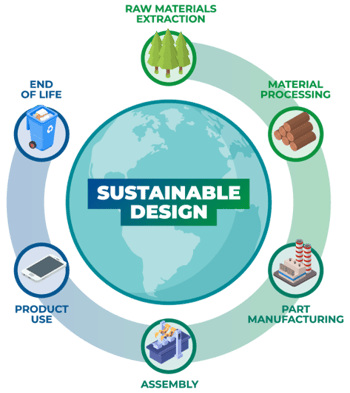
In the first of our new blog series, our CSR Specialist, Viktoria Lamprinaki, examines the case for using Aluminium as an alternative to less sustainable materials:
There are a lot of stages in the life of a product. From the conception of the idea and design development to its manufacturing and end use, everything affects the product’s overall sustainability. This includes what happens at a products 'end of life', which is equally important to the previous stages.

Research has shown that the choice of materials for a product is important when it comes to minimizing its environmental footprint. Products go through a life cycle that begins with production and ends with disposal. Raw materials are extracted from nature, made into useful goods, have a functional life and are eventually discarded. Sustainable practices look at each step in the cycle and seek to avoid negative environmental consequences.
For example, carefully managed tree cutting for wood production allows the forest to grow new trees at a rate that can keep up with the need for wood materials.

In this blog series we will present some of the most frequently-used materials and provide information about their sustainability. Some materials are more eco-friendly than others, but keep in mind that choosing the ‘right’ material is only part of the product’s 'lifecycle sustainability' and that we should be looking into all stages if we want to enhance the overall sustainability of the final product.
And, of course, it's important to remember that sustainability encompasses the environmental and the social responsibility of a product. Therefore we have to find the right balance between those two and not focus only on the eco-friendliness.
Aluminium
 Aluminium is a silvery-white metal, the 13th element in the periodic table. It’s the most widespread metal on Earth, making up more than 8% of the Earth's core mass and it’s also the 3rd most common chemical element on our planet, after oxygen and silicon. At the same time, because it easily binds with other elements, pure aluminium does not occur in nature. This is why we learned about its existence relatively recently. Aluminium was formally produced for the first time in 1824 and it would be another fifty years before it was produced on an industrial scale.
Aluminium is a silvery-white metal, the 13th element in the periodic table. It’s the most widespread metal on Earth, making up more than 8% of the Earth's core mass and it’s also the 3rd most common chemical element on our planet, after oxygen and silicon. At the same time, because it easily binds with other elements, pure aluminium does not occur in nature. This is why we learned about its existence relatively recently. Aluminium was formally produced for the first time in 1824 and it would be another fifty years before it was produced on an industrial scale.
What are its properties?
Aluminium offers a rare combination of valuable properties. It is one of the lightest metals in the world: it's almost three times lighter than iron but it's also very strong, extremely flexible and corrosion resistant because its surface is always covered in an extremely thin and yet very strong layer of oxide film. It doesn't magnetise, it's a great electricity conductor and forms alloys with practically all other metals.
- Lightweight: Three times lighter than iron
- Durable: Almost as much as steel
- Ductile: Easy to process
- Corrosion-resistant: Due to a thin surface layer of aluminium oxide
It can be easily processed using pressure, both when it's hot and when it's cold. It can be rolled, pulled and stamped. Aluminium doesn't catch fire, it doesn't need special paint and it's not toxic. It's also very pliable so sheets just 4 microns thick can be made from it, as well as extra thin wire.
How is it produced?[1]
Bauxite mining: The aluminium production process starts with the mining of bauxites, an aluminium rich mineral in in the form of aluminium hydroxide. About 90% of global bauxite supply is found in tropical areas.
Precipitation, Digestion, Crushing -Alumina production
Bauxite is crushed, dried and ground in special mills where it is mixed with a small amount of water. This process produces a thick paste that is collected in special containers and heated with steam to remove most of the silicon present in bauxites.
Electrolytic Reduction process
At an aluminium smelter, alumina is poured into special reduction cells with molten cryolite at 950℃. Electric currents are then induced in the mixture at 400 kA or above; this current breaks the bond between the aluminium and oxygen atoms resulting in liquid aluminium settling at the bottom of the reduction cell.
Casting- Primary aluminium
Primary aluminium is cast into ingots and shipped to customers or used in the production of aluminium alloys for various purposes.
Foundry alloys, Rolling, Extrusion -aluminium alloys
The process where the aluminium is shaped to its required form. This process is used for making the vast majority of aluminium products from spectacle frames, telephone bodies, aeroplane fuselages or spaceship bodies.
What about its sustainability?
Aluminium is considered a sustainable material especially due to its recyclability:
- Lightweight, strong and highly recyclable, aluminium products can lower energy costs and carbon emissions in dozens of applications.
- Independent studies have confirmed that aluminium has 20% smaller life cycle energy consumption than steel in transportation.
- Its light weight contributes to increased fuel efficiency in vehicles ranging from passenger cars to armoured tanks.
- The metal’s 95% light-reflectivity contributes cooling efficiencies to “green” buildings and improves the energy production efficiency of solar cells.
- It is 100% recyclable.
- It requires up to 95% less energy to recycle aluminium than to produce primary metal and thereby avoids corresponding emissions, including greenhouse gases.
A recycled drinks can:
- save enough energy to run your television for up to three hours
- will avoid CO2 emissions equivalent to a 1 mile car journey
- could be back on the supermarket shelf as another can within 60 days
Environmental Impact
Of course there are environmental impacts associated with each stage of aluminium production, from extraction to processing. The major environmental impact of refining and smelting is greenhouse gas emissions. The atmospheric pollutants from primary aluminium production also produce acid rain when they mix with water vapour. Aluminium poses no danger of environmental toxicity when soil pH remains at or above 5.0, however acid rain lowers the pH of soil and forces aluminium into solution. Due to its natural abundance, the amount of aluminium that enters the environment due to regular weather processes far exceeds anthropogenic contributions.
Our Approach
Our teams work to deliver to our clients innovative campaigns that encompass sustainability and deliver high quality items. For example, ASL worked with Coca-Cola and McDonald's on a major joint collectables promotion launched recently across Australia. Both brands were keen to create a more sustainable marketing campaign so ASL developed a new aluminium cup, which was packaged in 100% compostable bio-plastic bags. By taking this collaborative, CSR-driven approach, ASL was able to develop a much more sustainable activation for the client.
[1] https://www.aluminiumleader.com/production/aluminum_production/
Are you looking for innovative, sustainable marketing services support? Contact us to discover how ASL can help your marketing campaigns become more environmentally sustainable and socially responsible.

Discover more about our ONE WORLD initiative







